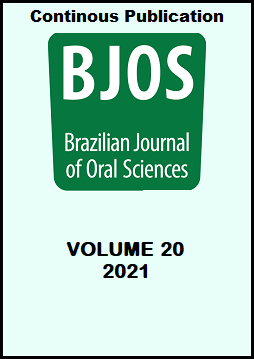Abstract
Aim: To investigate restorative decisions made by dentists and to examine what demographic characteristics are associated with the decisions for managing approximal and occlusal lesions. Methods: A questionnaire was randomly sent to 900 Palestinian dentists. It noted the demographic details of the dentists and the years of experience. The questionnaire evaluated the respondents for their treatment decisions regarding approximal and occlusal carious lesions. The data was analyzed using the IBM SPSS statistics for windows. The associations between gender and years of experience of the respondents and their restorative decisions were assessed. Results: The response rate was 58.2%. For occlusal carious lesions, 93.9% of the respondents would postpone operative treatment until the lesion was in dentine (grade 3 to 5). For approximal lesions, intervention was deemed appropriate by 92.6% of the respondents when there was radiographic evidence of a carious lesion reaching the DEJ or deeper. Around 53% preferred to prepare approximal lesions according to the traditional principles of cavity preparation. For both approximal and occlusal lesions, the participants opted for resin composites. Statistically, there was a significant association between the restorative decisions with the years since graduation and gender. Conclusion: The study showed variations between the treatment decisions of Palestinian dentists. The subjects chose conservative treatment plans but still adhered to traditional learned practices especially when cavity preparation for approximal lesions was concerned. The years since graduation and gender played a significant role in the choice of treatment opted for. Resin composites seemed to be a popular choice for treatment.
References
Dorri M, Sm D, Walsh T, Schwendicke F. Micro-invasive interventions for managing proximal dental decay in primary and permanent teeth. Cochrane Database Syst Rev. 2015 Nov 5;(11):CD010431. doi: 10.1002/14651858.CD010431.pub2.
Splieth CH, Kanzow P, Wiegand A, Schmoeckel J, Jablonski-Momeni A. How to intervene in the caries process: proximal caries in adolescents and adults—a systematic review and meta-analysis. Clin Oral Investig. 2020 May;24(5):1623-36. doi: 10.1007/s00784-020-03201-y.
Fontana M, Platt JA, Eckert GJ, González-Cabezas C, Yoder K, Zero DT, et al. Monitoring of Sound and Carious Surfaces under Sealants over 44 Months. J Dent Res. 2014 Nov;93(11):1070-5. doi: 10.1177/0022034514551753.
Liang Y, Deng Z, Dai X, Tian J, Zhao W. Micro-invasive interventions for managing non-cavitated proximal caries of different depths : a systematic review and meta-analysis. Clin Oral Investig. 2018 Nov;22(8):2675-84. doi: 10.1007/s00784-018-2605-9.
Walsh LJ, Brostek AM. Minimum intervention dentistry principles and objectives. Aust Dent J. 2013 Jun;58 Suppl 1:3-16. doi: 10.1111/adj.12045.
Laske M, Opdam NJM, Bronkhorst EM, Braspenning JCC, Van Der Sanden WJM, Huysmans MCDNJM, et al. Minimally invasive intervention for primary caries lesions: are dentists implementing this concept? Caries Res. 2019;53(2):204-16. doi: 10.1159/000490626.
Dallı M, Çolak H, Mustafa Hamidi M. Minimal intervention concept: a new paradigm for operative dentistry. J Investig Clin Dent. 2012 Aug;3(3):167-75. doi: 10.1111/j.2041-1626.2012.00117.x.
Kopperud SE, Tveit B, Opdam NJM. Occlusal Caries Management : Preferences among Dentists in Norway. Caries Res. 2016;50(1):40-7. doi: 10.1159/000442796.
Rechmann P, Doméjean S, Rechmann BMT, Kinsel R, Featherstone JDB. Approximal and occlusal carious lesions Restorative treatment decisions by California dentists. J Am Dent Assoc. 2016 May;147(5):328-38. doi: 10.1016/j.adaj.2015.10.006.
Doméjean S, Léger S, Maltrait M, Espelid I, Tveit AB, Tubert-Jeannin S. Changes in occlusal caries lesion management in France from 2002 to 2012: a persistent gap between evidence and clinical practice. Caries Res. 2015;49(4):408-16. doi: 10.1159/000381355.
Chana P, Orlans MC, O’Toole S, Domejean S, Movahedi S, Banerjee A. Restorative intervention thresholds and treatment decisions of general dental practitioners in London. Br Dent J. 2019 Oct;227(8):727-32. doi: 10.1038/s41415-019-0849-72.
Baraba A, Anić I, Doméjean-Orliaguet S, Espelid I, Tveit AB, Miletić I. Survey of Croatian dentists’ restorative treatment decisions on approximal caries lesions. Croat Med J. 2010 Dec;51(6):509-14. doi: 10.3325/cmj.2010.51.509.
Khalaf ME, Alomari QD, Ngo H, Doméjean S. Restorative treatment thresholds: Factors influencing the treatment thresholds and modalities of general dentists in Kuwait. Med Princ Pract. 2014;23(4):357-62. doi: 10.1159/000363184.
Ghasemi H, Murtomaa H, Torabzadeh H, Vehkalahti M. Restorative treatment threshold reported by Iranian dentists. Community Dent Health. 2008 Sep;25(3):185-90.
Suliman A, Abdo A, Elmasmari H. Restorative treatment decisions on approximal caries among practicing dentists in the college of dentistry clinics, Ajman University, United Arab Emirates. Open Dent J. 2020;14(1):97-102. doi: 10.2174/1874210602014010097.
Espelid I, Tveit AB, Mejàre I, Sundberg H, Hallonsten AL. Restorative treatment decisions on occlusal caries in Scandinavia. Acta Odontol Scand. 2001 Feb;59(1):21-7. doi: 10.1080/000163501300035724.
Tveit AB, Espelid I, Skodje F. Restorative treatment decisions on approximal caries in Norway. Int Dent J. 1999 Jun;49(3):165-72. doi: 10.1002/j.1875-595x.1999.tb00902.x.
Riley JL, Gordan V V., Rouisse KM, McClelland J, Gilbert GH. Differences in male and female dentists’ practice patterns regarding diagnosis and treatment of dental caries Findings from the Dental Practice-Based Research Network. J Am Dent Assoc. 2011 Apr;142(4):429-40.
Gordan V V., Bader JD, Garvan CW, Richman JS, Qvist V, Fellows JL, et al. Restorative treatment thresholds for occlusal primary caries among dentists in the Dental Practice-Based Research Network. J Am Dent Assoc. 2010 Feb;141(2):171-84. doi: 10.14219/jada.archive.2010.0136.
Doméjean-Orliaguet S, Léger S, Auclair C, Gerbaud L, Tubert-Jeannin S. Caries management decision: Influence of dentist and patient factors in the provision of dental services. J Dent. 2009 Nov;37(11):827-34. doi: 10.1016/j.jdent.2009.06.012.
Ten Cate JM. Remineralization of deep enamel dentine caries lesions. Aust Dent J. 2008 Sep;53(3):281-5. doi: 10.1111/j.1834-7819.2008.00063.x.
Hörsted-Bindslev P, Heyde-Petersen B, Simonsen P, Baelum V. Tunnel or saucer-shaped restorations: a survival analysis. Clin Oral Investig. 2005 Dec;9(4):233-8. doi: 10.1007/s00784-005-0011-6.
Heaven TJ, Gordan V V, Litaker MS, Fellows JL. Agreement among dentists ’ restorative treatment planning thresholds for primary occlusal caries , primary proximal caries , and existing restorations: Findings from The National Dental Practice-Based Research Network. J Dent. 2013 Aug;41(8):718-25. doi: 10.1016/j.jdent.2013.05.014.
Kakudate N, Sumida F, Matsumoto Y, Manabe K, Yokoyama Y, Gilbert GH, et al. Restorative Treatment Thresholds for Proximal Caries in Dental PBRN. J Dent Res. 2012 Dec;91(12):1202-8. doi: 10.1177/0022034512464778.

This work is licensed under a Creative Commons Attribution 4.0 International License.
Copyright (c) 2021 Brazilian Journal of Oral Sciences


